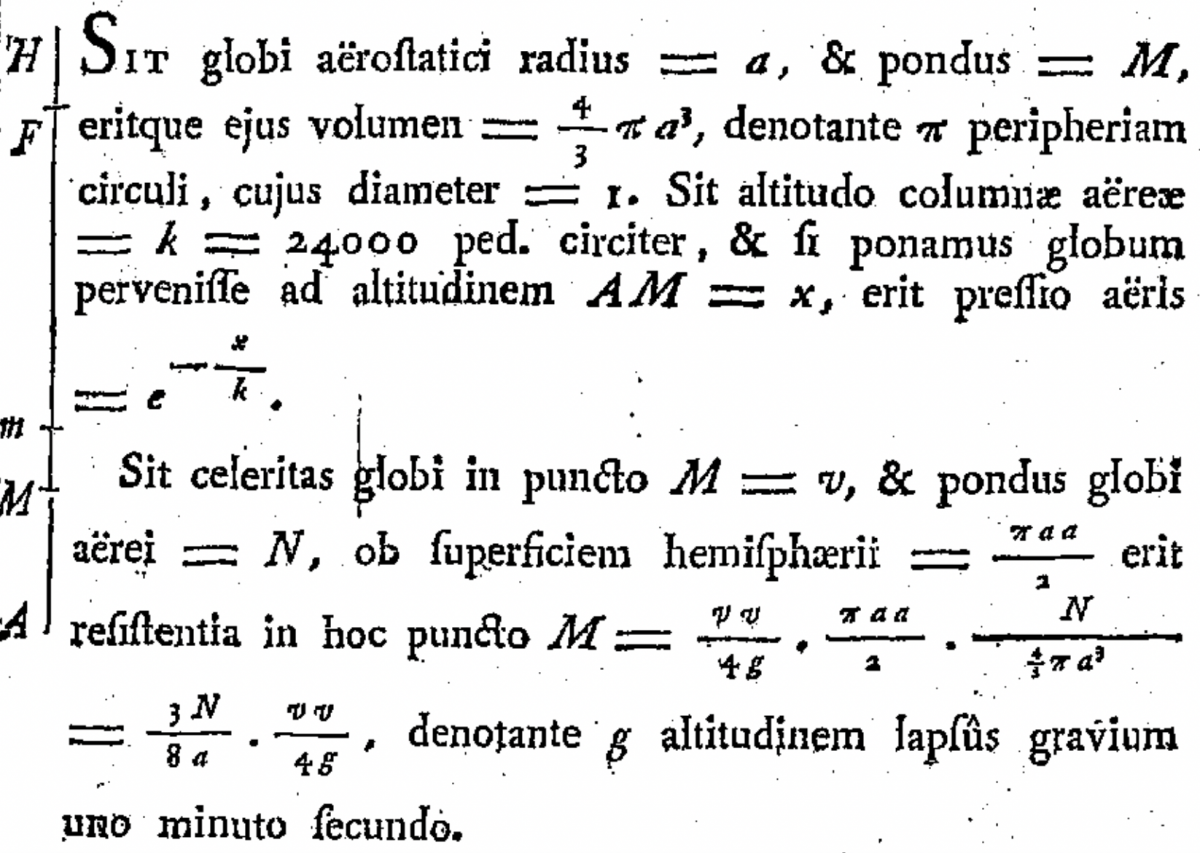- About MAA
- Membership
- MAA Publications
- Periodicals
- Blogs
- MAA Book Series
- MAA Press (an imprint of the AMS)
- MAA Notes
- MAA Reviews
- Mathematical Communication
- Information for Libraries
- Author Resources
- Advertise with MAA
- Meetings
- Competitions
- Programs
- Communities
- MAA Sections
- SIGMAA
- MAA Connect
- Students
- MAA Awards
- Awards Booklets
- Writing Awards
- Teaching Awards
- Service Awards
- Research Awards
- Lecture Awards
- Putnam Competition Individual and Team Winners
- D. E. Shaw Group AMC 8 Awards & Certificates
- Maryam Mirzakhani AMC 10 A Awards & Certificates
- Two Sigma AMC 10 B Awards & Certificates
- Jane Street AMC 12 A Awards & Certificates
- Akamai AMC 12 B Awards & Certificates
- High School Teachers
- News
You are here
Things Certain and Uncertain: Enter Euler
For his final work in E579, Euler divided his analysis of the motion of a rising aerostatic balloon into three major parts. In the first part, he calculated air resistance and used it to find an expression for the velocity of the balloon at any altitude. Next, he determined the maximum altitude the balloon could attain and the time of ascent to this maximum altitude. Finally, he determined the maximum speed that the balloon would attain. The article ends with a sample calculation for a balloon of a particular size and weight.
To prepare for the calculation, Euler set \(a\) as the balloon’s radius, \(M\) as its weight, and \(N\) as the weight of the surrounding air displaced by the balloon. Of course, the mass of a fixed volume of surrounding air will diminish as altitude increases, so Euler would also need take atmospheric pressure into account. He accomplished this by introducing the approximate scale height (i.e., the height of an air column) of \(k=\) 24,000 feet. Using \(x = AM\) for the balloon’s altitude, air pressure at that altitude is modeled by \(e^{-x/k}\). Since Eulers analysis predated SI units, he did not have the luxury of measuring pressure in pascals; instead, he used a system in which air pressure at ground level is equal to 1.

Figure 4. Euler's setup for the calculation in E579, with a diagram in the left margin showing a column of air stretching
from \(A\) (on the ground) to \(H\) (at an altitude of 24,000 feet). The balloon is located at the point \(M\). The Euler Archive.
Then, in a turn that might be unexpected for a modern reader, Euler used \(g\) as the distance fallen in one second by an object subject only to gravity (i.e., \(g=16\) feet). This is another situation in which Euler’s units differed from a modern approach—today, we would instead use the acceleration due to gravity (say, \(g'\)), which equals \(2g\) feet per second per second. His resulting expression for air resistance—or, drag—at point \(M\) is
\[
\frac{vv}{4g}\cdot\frac{\pi aa}{2}\cdot\frac{N}{\frac{4}{3}\pi a^3}.
\]
With a little work, this can be made to align with the modern drag equation:
\[
\frac{1}{2}\left(\frac{v^2}{2}\right)\cdot\left(\pi a^2\right)\cdot\left(\frac{N/g'}{\frac{4}{3}\pi a^3}\right),
\] where the coefficient \(\frac{1}{2}\) approximates the drag coefficient for a sphere, the second factor corresponds to the maximal cross-sectional area of the balloon, and the third factor gives the density of displaced air at ground level. (As we know, Euler would eventually need to account for the decrease in atmospheric density as the balloon ascends.)
Force and Buoyancy
For now, he simplified his drag equation as \(\frac{3N}{8a}\cdot\frac{vv}{4g}\) and invoked the “principle of mechanics” (known today as Newton’s second law): \[2v \partial v=\frac{4g \partial x}{M} \cdot P,\] where \(P=\frac{M}{2g}\cdot v \frac{\partial v}{\partial x}\) was Euler’s way of expressing the relation Force = Mass \(\cdot\) Acceleration. (Here, the differential of \(v^2\) is written as \(2v\partial v\).) Euler’s goal was to equate \(P\) with the total of forces acting on the balloon. The net force acting on a rising balloon is the difference between the buoyant force \(Ne^{-x/k}-M\) and the drag force \(\frac{3N}{8a}\cdot\frac{vv}{4g}\): \[P \;=\; N e^{-x/k}-M-\frac{3N}{8a} \cdot \frac{vv}{4g} \cdot e^{-x/k}.\] For the buoyant force, Euler used Archimedes’ principle implicitly by subtracting the balloon’s weight from the weight of the displaced air (now accounting for the atmospheric pressure at altitude \(x\)).
To put it all together, Euler set \(b = \frac{8a}{3 \lambda}\) and wrote his differential equation as
\[
2v \partial v + \left(\frac{1}{b} \cdot vve^{-x/k}\right) \partial x = 4g \left(\lambda e^{-x/k}-1\right)\partial x, \;\;\;\;\;\;\;\; (1)
\]
with \(\lambda = \frac{N}{M}\) being his way of measuring a sort of "buoyancy ratio." A higher value for \(\lambda\) corresponds to a more buoyant balloon, while \(\lambda = 1\) corresponds to a balloon filled with unheated air.
Solving the Differential Equation
As it stands here, Euler had a problem: this equation is not solvable! However, he circumvented this problem with some creative approximations. Taking a linear approximation \(e^{-x/k} \approx 1-\frac{x}{k}\) on the right side of the equation and a coarser approximation of \(e^{-x/k} \approx 1\) on the left side, he obtained
\[
2v \partial v + \left(\frac{1}{b} \cdot vv\right) \partial x \;=\; 4g \left(\lambda-1-\frac{\lambda x}{k}\right)\partial x,
\]
which can be solved by using an integrating factor method. Specifically, multiply through by \(e^{x/b}\) to get
\[
\partial \left( v^2e^{x/b} \right) \;=\; 4g \left(\lambda-1-\frac{\lambda x}{k}\right)e^{x/b}\,\partial x.
\]
After integrating (implicitly over the interval \([0,x]\)), Euler obtained
\[
v^2e^{x/b} \;=\; \frac{4\lambda gb}{k} \left((b+f)(e^{x/b}-1)-xe^{x/b}\right),
\]
where \(f = \big(1-\frac{1}{\lambda}\big)k\). With a little adjustment, we arrive at the equation
\[
v^2 \;=\; \frac{4\lambda gb}{k} \left((b+f)(1-e^{-x/b}) - x\right),
\]
which Euler reminded us is “an expression which determines the speed of the sphere at any altitude.”
Michael P. Saclolo (St. Edward’s University) and Erik R. Tou (University of Washington Tacoma), "Things Certain and Uncertain: Enter Euler," Convergence (May 2023)




